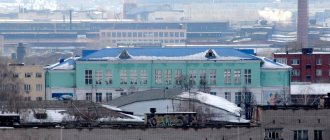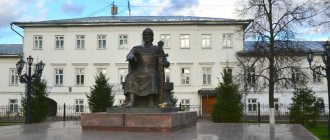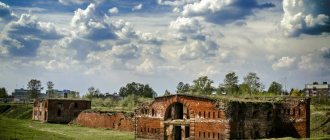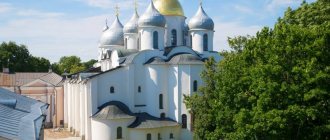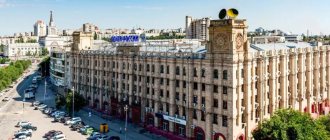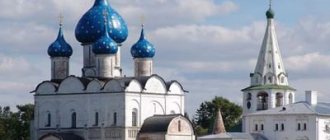General information and history of Sarapul
Sarapul is one of the oldest cities in the Kama region, a city located in the southeastern part of the Udmurt Republic, on the right bank of the Kama River.
The distance to Izhevsk is 62 km, to Moscow – 1250 km. A village called Sarapul appeared in 1707, and city status was received in 1780. A fairly favorable geopolitical and geographical location helped Sarapul gain the unofficial status of one of the most successful cities in the Kama region.
Sarapul. View of the city center from the Kama River
Sarapul is home to a large number of architectural monuments. Previously, the city had 33 churches and 2 monasteries. Currently, the Church of the Ascension, Intercession and Xenia of St. Petersburg have been preserved.
Ascension Church
Today Sarapul is a major industrial center of the Udmurt Republic. The joint-stock enterprises radio and electric generating plant are the industrial face of the city.
Climate and ecology of Sarapul
Sarapul is located in a zone of temperate continental climate (consistently hot summers, consistently cold winters and low precipitation). The average annual temperature is +3.4 °C (in summer the thermometer can rise to +36 °C, and in winter it can reach -34 °C). The average annual wind speed is 3.1 m/s, and air humidity reaches 69.7%.
Winter in Sarapul
The ecological state of the city cannot be called terrible, but it does not qualify for an “excellent” rating. The main sources of air pollution include public utilities, metalworking and machine-building enterprises, as well as enterprises specializing in the food industry.
As for reservoirs, the most polluted rivers are the Kama and Bolshaya Sarapulka. They are negatively affected by such enterprises as the Sarapul Machine-Building Plant, a poultry factory, a meat processing plant and a radio plant. Sources of pollution also include household waste dumps growing in the south and west of Sarapul.
Izhboldins - a family of philanthropists
The Izhboldin family, their surname is symbolic: according to one version, it originates from the ancient ancestor Ishboldu and translated from Turkic means “one who provided himself with business.” According to another version, it comes from the Bashkir male name Ishbuldy, which translated into Russian means “who has become a friend.”
It is noteworthy that the bright representative of this dynasty, Olga Ivanovna Izhboldina, was the sister of the famous Russian artist and landscape painter Ivan Ivanovich Shishkin.
The Shishkins, to whose family Olga Izhboldina belonged, were pious people; in addition, they had their own bell production. They cast church “bells” in Yelabuga at a bell foundry, which was passed down from generation to generation in their family until 1917. The 515-pound bell they made for the Assumption Cathedral in Yaransk (1847) is known. The artist Ivan Shishkin often visited Sarapul, visiting his sister, and spoke highly of the nature of these places.
Olga Izhboldin's husband, merchant of the 1st guild Dmitry Grigorievich, continued the social and charitable activities of his father and brother, holding the positions of mayor, burgomaster of the city magistrate and honorary justice of the peace. Dmitry Izhboldin was awarded the title of honorary hereditary citizen of Sarapul.
The children of Dmitry and Olga Izhboldin were worthy heirs. The eldest son, Ivan Dmitrievich, was the guardian of many city institutions - hospitals, charity homes, gymnasiums, parish schools.
Population of the city of Sarapul
At the beginning of 2014, 99,869 people lived in Sarapul. The city is multinational: 82% of the population are Russians, 9.2% are Tatars, 3.8% are Udmurts, and the remaining 5% of the population accounts for more than sixty nationalities.
Day of the city
It is worth noting that the mortality rate in Sarapul (as well as in the Udmurt Republic as a whole) exceeds the birth rate. There are often cases when residents leave the city, moving to larger settlements, which, together with the previous factor, leads to a decrease in the city’s population.
The level of education and morality in the city is high, because there are many different educational institutions in Sarapul. In addition, in 2010, the Public Council of the Municipal Municipality “City of Sarapul” was organized, which included representatives of 20 associations and public organizations of the city. At the same time, the total number of public organizations reaches 40 (trade unions, religious, national-cultural, veterans, etc.).
Father of the legendary cavalry maiden Nadezhda Durova
Mayor Andrei Vasilyevich Durov is one of the most famous residents of Sarapul in its entire history.
In Russian history, Andrei Vasilyevich is best known as the father of Nadezhda Durova, the legendary cavalry maiden. For Sarapul, the mayor was the true father of the city, who did a lot for its improvement and prosperity. Vyatka nobleman, participant in the Russian-Turkish wars A.V. Durov was appointed by the governing Senate to the post of mayor of Sarapul in 1789 and held this position for 36 years.
Under him and with his assistance, the first educational institution - the Small Public School - and the first city hospital with 11 beds were opened in Sarapul, local merchant dynasties and the city-forming leather industry were born, the first stone buildings appeared, and urban development took shape. Thanks to the mayor, in 1802 the main temple of the then Sarapul, the Ascension Cathedral, was dismantled to its foundations and re-erected, having significantly expanded.
Districts and real estate of Sarapul
Sarapul is a provincial town, officially divided into 8 districts, including Center, Startseva Gora, Privokzalny, Novoselsky, Yuzhny, Gudok, Yamy and Simonikha.
Sarapul Map
Now we will consider each district of the city of Sarapul separately, paying attention to residential buildings and the estimated cost of apartments.
The center is the heart of the city. There are administration buildings, museums, a church and many retail outlets here. The central region borders the Kama River, so there are plenty of picturesque places here. Unfortunately, in the very center of the city there are many buildings built more than a century ago that are in need of reconstruction. Restoration work is underway, but extremely slowly, so we can only hope that the center of this beautiful town will someday take on a more decent appearance.
There are not many residential buildings in the Central District; these are mainly private wooden houses, many of which are in need of repair.
Sarapul city administration building
Startseva Gora is a fairly quiet and peaceful area of the city, despite its proximity to the center of Sarapul. It is pleasant to walk along the streets of this area, because cleanliness and order reign here, and numerous trees complete the picture.
Startseva Gora is a very old area; it is not surprising that the only buildings here are wooden residential buildings. An excellent place for lovers of beautiful landscapes and fishing, since the Kama River is literally a stone's throw from here.
Startseva Mountain
The station area is located in the southwestern part of the city. It is not difficult to guess that the railway station is located here. Despite the distance from the city center, the Station area is full of life. Of course, the small town falls asleep at night, but during the day its streets are quite lively. Among the residential buildings there are 5-story and 4-story buildings, and the cost of a one-room apartment in the area exceeds 800 thousand rubles. It is worth adding that gardening plots have found their place on the outskirts of the Station District.
Novoselsky is a tiny area, more like a village. Forest, river, paths, garden plots, wooden houses... The Novoselsky district is a valuable area from an urban planning point of view, it is quite possible that in the future 4, 5 or even 9-story residential buildings will rise here.
Novoselsky District
The southern district is even more remote from the center of Sarapul, but a considerable part of the townspeople live here. The area is separated from the rest of the city by garage cooperatives, a railroad, and a forest. In the Southern district, 5- and 9-story residential buildings were erected, and construction continues today. The cinema center and the city market are also located here. A one-room apartment in this area will cost buyers 700-900 thousand rubles.
Southern region
Yamy is an urban area located east of the shoe factory. The area owes its name to the massive garage construction and vegetable pits located in garages. There are not many residential buildings here; most of them are one-story wooden or stone houses.
Yama area
The northernmost district of Sarapul is Gudok. Smooth streets, good roads, but not a single multi-story building. Private residential buildings are being built here, but the area’s somewhat remote location from the bank of the Kama River makes its land less valuable than, for example, plots located on Startsevaya Mountain.
House. Gudok District
On the left bank of the Kama there is a microdistrict of the city of Sarapul called Simonikha. Life used to be in full swing here, but the construction of the Nizhnekamsk hydroelectric power station led to the flooding of the village. Most of the local residents were resettled, and the post office, kindergartens, and schools were closed. In the summer, the passenger ferry of the Sarapul River Port OJSC operates here, and in the winter, residents of Simonikhi cross the river on ice.
City infrastructure
The work of representatives of the housing and communal services complex can only be assessed as “satisfactory”, because even in the very center of the city there are many buildings that are in disrepair. However, repair and restoration work is being carried out, but not at all on the scale required. So, for 2008-2011 About 185 million rubles were allocated for major repairs of residential buildings. As a result, 176 apartment buildings were renovated, with a total area of 151 thousand square meters. m, and 18,037 people live in them. The supply of water, gas and electricity is carried out regularly, however, emergencies still arise from time to time, but the problems are resolved quickly enough.
One of the Sarapul courtyards
The cost of utilities cannot be called low: currently, owners of average one-room apartments pay about 2,000 rubles monthly. It is worth adding that this amount is getting higher every year, but this problem is also familiar to residents of other Russian cities.
In a relatively small city, traffic jams are out of the question. The problem of terrible road surfaces, so well known in Russia, has not spared Sarapul. Driving along some city streets is becoming more and more problematic over time. We can only hope that in the near future the city administration will pay more attention to this problem.
Quickly getting from one district of Sarapul to another will not be difficult, because there are more than 100 private taxis in the city, and 22 bus routes cover all city districts. There is also water transport in Sarapul. From May to October, two water routes “Sarapul-Barok” and “Sarapul-Ershovka-Simonikha” are opened for citizens.
You can get a good education in Sarapul without any problems. On the territory of the city there are 18 general education institutions, 3 correctional education institutions, 32 preschool education institutions and 7 additional education institutions.
Documents for the history of Sarapul
Graves discovered in the city of Sarapul on Opolzin
In the last days of May and the beginning of June, this year, while excavating for the construction of a water supply system in the city of Sarapul, on Startsevaya Hill, adjacent to the city, workers discovered human bones.
After a careful investigation of the site, two graves were discovered filled with bones of people of different sexes and ages buried in them. The graves were of various sizes. One reached a length of approximately 8 fathoms, had a direction from east to west, and was located several fathoms south of the second. The other was about three fathoms long and ran parallel to the first.
The depth of both graves was approximately a fathom, and the width was four to five arshins. The graves were located at the same depth from the surface of the earth, no more than an arshin, except for the occasional unevenness of the place itself. Due to the slight slope towards the Kama, the bones of the first grave were located 2-3 inches from the surface of the earth at the beginning of the excavation. Both graves were lined with wood. Next to the northern grave, there were apparently burial pits located almost closely, which had long been covered with earth.
Based on the finds found in these graves, one can notice some differences between them. Not a single cross was found in the southern grave, but in the northern one there were several dozen four-pointed crosses, some of which were wrapped in a canvas rag. There was also a difference in the way the corpses were buried. The corpses of infants buried in the southern grave were wrapped in birch bark, while the larger corpses were apparently wrapped in canvas. In the northern grave, excavations did not reveal the presence of either one or the other. Only one ancient button was found here and transferred to the Sarapul Museum along with several crosses.
A small treasure of silver coins (efimki) from the time of Mikhail Fedorovich (1613-1645) was found at the graves, on which the inscription was preserved:
"Tsar and Grand Duke Mikhail Fedorovich of All Rus'."
As for the burial of the corpses, they were simply dumped in one and the other grave. Only in the direction of the corpses in the large grave was more correctness noticed: the corpses had their feet facing east, although the babies, wrapped in birch bark, were at an angle to them. All the corpses lay in the graves completely incorrectly: on their backs, on their stomachs, on their sides, as can be seen in photographs taken of the skulls in their untouched position, stored in the Sarapul Museum.
No damage to bones or skulls from any firearms or bladed weapons was found; one part of the bones had decayed with time, while the other was fairly preserved. According to Dr. M. M. Khomyakov from Kazan, up to 80% of the skulls he took away, taken not from graves, but from the general pile of already dug up skeletons, were of Mongolian origin. This was the extent of all the finds at Opolzin.
The question arises, who did the open graves belong to, and to what time do they and those Mongolian skulls that were extracted from the graves date back to?
To resolve these issues, it is necessary to make a historical note about the past of the city of Sarapul and its surrounding areas.
In the 12th century, Bulgarians lived in areas adjacent to the present city of Sarapul. They already had their own cities and capital, which were at times subject to attacks by Russian princes. In 1164, the Vladimir-Suzdal prince Andrei Bogolyubsky undertook a campaign against the Bulgarians, took their city of Bryakhimov with a fortress, from which the current “Devil's Settlement” remains, near the city of Yelabuga, and in 1222 the Russian princes devastated the cities of Zhukotin near Chistopol, and Oshel near mouth of the Kama.
During the struggle of the Russian princes with the Bulgarians and their various neighbors, the Russian colonization of the Kama region began and the final disappearance of the Bulgarian cities. The Kama River, being one of the main routes leading Russian colonists to Vyatka, was soon, of course, populated by Russians itself. And Ivan the Terrible, having undertaken a campaign against Kazan in 1552, already had active support in the fight against the Tatars from the Russians who lived in the Kama region.
At the end of the 16th century, Sarapul was already mentioned in acts. “In Sarapul and Siva they catch fish from dues and the Permyaks take their hops from Osa...” In 1619, the rebellious Kazan Tatars, Bashkirs, Chuvashs, Cheremis and Votyaks “kept the suburbs of Sarapul and Osa under siege.” According to the patrol book of 1621, in the village of Voznesenskoye, on Sarapul I, there were 195 households, that is, up to a thousand or more inhabitants.
Thus, historical information about the past of Sarapul sufficiently explains the presence of Mongolian-type skulls in the graves along with Christian burials of Russians, who apparently once lived in the neighborhood. The vastness of the graves indicates that these were common graves for burying the dead.
The time of origin of these graves can be approximately determined by the found coins from the time of Mikhail Fedorovich, i.e. the graves can presumably be dated back to the beginning of the 17th century.
What was the reason for the mass graves in which numerous corpses of women, men and children were buried hastily and in disorder?
Historical information about the causes of this phenomenon indicates epidemics that often visited the city of Sarapul. Due to the absence of traces of weapons on the skulls, these common graves should be attributed to the history of epidemics and in particular the plague, and not battles. “The plague in Russia, writes the doctor F. Streltsov in his correspondence, first appeared in the 11th century, then appeared in the 13th century, and the most terrible epidemic, called the Black Death, broke out in Europe in the 14th century and in 1351 in two ways through Poland and Astrakhan, penetrated into Russia. The mortality rate from this epidemic exceeded all epidemics that have ever occurred before or since.”
In Sarapul, a “pestilence”, which should be considered a plague, then appeared in 1607 and in 1657. During the last of these epidemics there were also so many dead that the priests did not have time to bury them. Many human corpses lay unattended in cities and villages along the streets. Comparing all these chronological data, one should come to the conclusion that the large grave located to the south was the result of a plague epidemic that occurred in 1351, and since Bashkirs lived on Opolzin at that time, the bones, therefore, belong to Bashkirs belonging to the Mongolian tribe.
The smaller northern grave is filled with the bones of Russians who died during the plague of 1607, or, most likely, 1657, which, apparently, was more severe than the previous one. That both graves are of such ancient origin, in addition to the above considerations, is also evidenced by the fact that the hair that was found during excavations 18 years ago in the cathedral square, where corpses that had been in the ground for more than a century, were dug out, did not survive, since the cemetery with this The square was transferred to Troitskaya in 1772.
Thus, the origin of the graves discovered in the city of Sarapul on Opolzin is clarified. These are common graves, one belonging to the south, more ancient, to the Bulgarians or their fellow Bashkirs who died from the plague and dates back to the 14th century, the other to Russian Christians who died from the same disease in the 17th century.
Reported by V. Emelyanov. Proceedings of the Vyatka Scientific Archival Commission. 1909 Vol. I-III. – Vyatka, 1909. – P. 72-78.
Enterprises and work in Sarapul
The economic basis of the city is a large industrial complex, the main industries of which include mechanical engineering, food and light industry, production of building materials, plastic products, floriculture and printing.
Mechanical engineering is a leading industry, with the main specialization being the production of defense products, as well as products for civilian use. About 30% of the employed population of Sarapul works at the city’s machine-building enterprises. (At the beginning of 2012, there were 60,003 people of working age). The main enterprises in this industry are OJSC Sarapul Electric Generator.
Sarapul Electric Generating Plant
An important economic component of the city are food industry enterprises, whose products are supplied far beyond the borders of Sarapul and Udmurtia (bakery products, flour, dairy products, meat products, wine and vodka products). This industry is represented by the enterprises of ZAO Sarapulsky Beer, OJSC Sarapul Distillery and Vodka Plant, etc.
Light industry in Sarapul is represented by enterprises specializing in clothing and footwear production. The production of clothing is carried out by Sarapul Sewing Factory Mercury LLC, and the production of shoes is carried out by specialists from Shoe Factory Sarabella-Holding LLC.
Unfortunately, the average salary in the city can hardly be called decent. So, in 2009, residents of Sarapul received an average of 10,300 rubles.
Cultural Sarapul: museums and theaters
Sarapul, although not very large in size and population, has its own museums and theater. Some of them are known even outside of modern Udmurtia, so if possible it is worth taking the time to visit them.
Museum of Academician Melnikov
- Address: st. Efima Kolchina, 37.
The museum is historical and biographical and is dedicated to the life of a mining scientist who made a significant contribution to the development of this science. Melnikov’s main achievements are considered to be work related to the development of methods for crushing rock by explosions, the development of methods for determining all kinds of parameters of specialized machines, as well as various issues regarding the development of the mining industry in general.
The exhibition itself is located in a wooden house where the scientist’s family lived in the first decades of the 20th century. On its ground floor, it was possible to restore the interior of the living quarters of that time in the family of a shoemaker working at home. The second floor is entirely dedicated to Melnikov’s scientific activities.
Museum of History and Culture of the Middle Kama Region
- Address: Pervomaiskaya st., 68.
The museum is the oldest in Udmurtia. It was established by the local district zemstvo in 1909. During the Second World War, 35,000 exhibits that belonged to Leningrad museums were evacuated here.
Today, there is a large unique collection of the museum’s own exhibits collected over more than a century of the museum’s history. In total there are now about 200,000 of them. The museum is now a repeated winner of competitions, both at the regional and national levels.
Radio Factory Museum
- Address: st. Gogol, 40U.
On the territory of the plant, which operates in the radio industry, there is a small but colorful museum, where a good exhibition of old samples of radio equipment has been selected. Reviews do not highlight this place in any way, saying that it is an ordinary museum at a factory. But visiting it is still recommended.
Drama Theater
- Address: Pervomaiskaya st., 22A.
The first theater on a professional basis in Sarapul was opened in 1911. And today the creative team continues to rely on the rich not only theatrical, but also cultural and historical heritage passed on to them.
For more than a century, contributions to it were made by such an outstanding theater figure as Skibnevsky, who worked here as artistic director in 1937-1944, as well as the actress Miklashevskaya, who served as Yesenin’s muse. Today, the theater is visited annually by more than 32,000 spectators of different ages.
Crime
Sarapul is a quiet and calm city, but even here the crime rate does not even think of reaching zero. It is not difficult to guess that many crimes are purely domestic in nature, and most of such acts occur as a result of excessive alcohol consumption. However, more high-profile crimes also happen in Sarapul. For example, drug trafficking cases regularly surface in the city. So, in 2011, a trio was convicted here for selling heroin to local drug addicts.
During 3 months of 2012, 404 crimes were committed in Sarapul. Statistics say that 80% of them are committed by non-working persons, while 40% of crimes are committed while intoxicated. It is worth adding that every second out of five criminal acts is committed by persons who have been prosecuted before.
An analysis of the operational situation shows that property theft is the most common type of crime in Sarapul.
The Sarapulsky Department of the Ministry of Internal Affairs of Russia is trying to maintain control over the crime situation, trying to reduce the number of crimes to a minimum. Let's hope that the quiet town of Sarapul will one day become absolutely safe.
